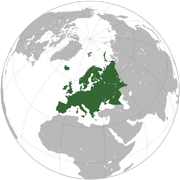
Europe as it is modernly defined.
Europe is one of the seven traditional continents of the Earth. Physically and geologically, Europe is the westernmost peninsula of Eurasia, west of Asia. Europe is bound to the north by the Arctic Ocean, to the west by the Atlantic Ocean, to the south by the Mediterranean Sea, to the southeast by the Caucasus Mountains and the Black Sea and the waterways connecting the Black Sea to the Mediterranean. To the east, Europe is generally divided from Asia by the water divide of the Ural Mountains, the Ural River, and by the Caspian Sea.
Europe is the world's second-smallest continent in terms of area, covering about 10,400,000 square kilometres (4,010,000 sq mi) or 2.0% of the Earth's surface. The only continent smaller than Europe is Australia.
Historically, Europe has been one of the most conflicted regions of the world. From the 16th century until the early part of the 20th century, various countries in Europe maintained vast overseas empires, with the end result that European poltics dominated the globe. Conflict amongst the various countries of Europe often led to conflict in North America, Asia, and Africa.
Europe in 1632[]
Europe was embroiled in the Thirty Years' War until the arrival of Grantville entirely changed the conflict. Through 1632, Gustavus Adolphus of Sweden and American Michael Stearns forged an alliance between Adolphus and Grantville, creating the Confederated Principalities of Europe. The presence of Grantville and the Confederated Principalities led to the opposing European alliance, the League of Ostend, formed by France, England, Spain, and Denmark. The League attacked the Dutch Republic, destroying its navy and allowing Spanish forces led by Don Fernando to occupy much of the Netherlands.